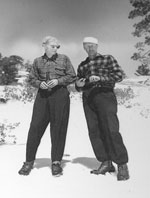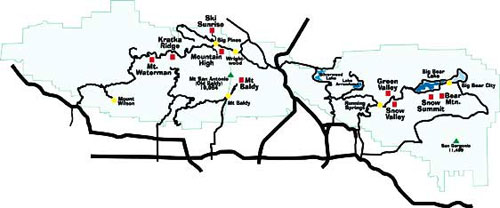 |
||
 |
 |
|
![]()
|
An Overview of Skiing in Southern California Check out our developing timeline of skiing in Southern California.
• Angeles NF • San Bernardino NF • Other • Lost Ski Areas • Skiing was slow to catch on in Southern California, the land of sun, sand and palm trees. But by the 1930s, skiing took off largely because of the ski jumping craze that had taken over the country. The first jump in the Southland was installed at Big Pines in 1929. It was at the Third Annual Winter Sports Carnival at Big Pines in 1929 that the Los Angeles Junior Chamber of Commerce made a bid for the 1932 Olympics. The 30s and 40s saw an explosion of skiing with small ski areas, using rope tows, springing up all over. In Big Bear Valley, these areas were spread out from Moonridge on the east to the Upper Mill Creek on Skyline Drive near Bluff Lake on the west. 1952 was the beginning of many dry winters that would last well into the 60s and forced the closure of most all of the small ski areas and threatened the existence of the larger ones. In 1958, Chuck Smith, Rebel Ridge Ski Area, began experimenting with making snow and proved that snowmaking was an economically viable solution for the area. Tommi Tyndall, Snow Summit, was the first to install it extensively. One of the unique aspects about the Southern California ski areas is that (on a clear day) you can see the ocean from the slopes of Mt. Baldy, Snow Summit, Snow Valley, and Big Bear Mountain. • Top • Angeles NF • San Bernardino NF • Other • Lost Ski Areas • The ski resorts of the Angeles National Forest largely rely on natural snow since they do not have the supply of water that can be found at Big Bear in the San Bernardino National Forest. Angeles Crest Resorts consist of two ski resorts (Mt. Waterman & Kratka Ridge), a snow play area and a Nordic area. Rick Metcalf and his crew bought the resorts in June 2006. Mt. Waterman claims to have had the first chairlift in Southern California in 1942, built by then owner Lynn Newcomb, Sr. The ski business began here with a rope tow in 1938. Joe Diener, one of the12 members of the San Gorgornio Ski club, scratched Kratka Ridge out of the mountains in 1950. For many years, it was known as Snow Crest but has gone back to being called Kratka Ridge. These resorts have not operated since 2001 or 2002. Buckhorn Ski Area was built in the 50s. Consisting of an overnight lodge and 2 tows, it is still owned and operated by the Buckhorn Ski & Snowboard Club. Blue Ridge was first operated with a rope tow. In the early 40s, championship teams practiced at Blue Ridge, one of the oldest ski area in the country. In 1937, the Blue Ridge Ski Area was taken over by Frank Springer and Tom Triol and received its first chairlift (Southern California's second) in 1947. In 1975, Dick Woodworth bought the resort and named it Mountain High Ski Area. Holiday Hill was established in 1948 by Joseph "Sepp" Benedikter and John Steinmann and received its first chair in 1950. In 1951 Steinmann bought out Benedikter and Holiday Hill became a family operation with Steinmann's sons Heinz, Hans and Kurt assisting with management and expansion responsibilities. The Steinmann brother bought Holiday Hill from their father in 1959. In 1962 Heinz bought out his brothers and with his wife, Lora, made many improvements and expanded the facilities. Around 1979, the Steinmanns sold Holiday Hill to a group of investors who then resold it a couple of years later. Terry Tognazzini bought Mountain High in 1979 and Holiday Hill in 1980 and renamed the combined resorts New Mountain High Ski Areas. June 14, 1997, Oaktree Capital Management bought Mountain High with hopes of eventually developing Sawmill Canyon and physically connect East and West Mountain High. Ski Sunrise (formerly Table Mountain Ski Area) is one of the few upside down resorts— you drive to the top of the mountain and ski down. Ski Sunrise started with a rope tow in 1938 on Table Mountain. Harlow "Buzz" Dormer obtained the original lease for Table Mountain in 1937 in partnership with Craig Wilson. Howard More bought the lease in 1943 and after thirty years of operation sold it to Tamount, Inc., a group of four investors, headed by Dave Ward. They changed the name to Ski Sunrise in 1975. More forclosed on their loan and regained control in 1993. Howard More sold Ski Sunrise to Oaktree Captial Management who owns Mountain High in 2004. In the short term, Mountain High will use Ski Sunrise for teaching and snow play. Mt. Baldy Ski Tows was formed in 1944 at Camp Baldy on “Movie Slope” by Herb Leffler and Jim Chaffee. In 1952, a group of skiers from the Southern Skis Club, led by Morgan Adams Jr., Bob Crary, Bob Cheesewright, Cortlandt T. Hill, Wesley B. Hadden, Judge Andrew Hauk, and J. Stanley Mullin, joined the corporation and a permit was obtained from the USFS to open up Thunder Mountain. They brought in Emile Allais, a famous French skier, to be their first ski school director. In 1952, Mt. Baldy Ski Lifts opened two new lifts. In 1969, Herb sold the resort to Chuck Lewadder, Western Resorts Corporation. • Top • Angeles NF • San Bernardino NF • Other • Lost Ski Areas • An ample supply of water in Big Bear Lake allows for Snow Summit and Big Bear Mountain to operate all winter in the case of a lack of natural snow. Big Bear Mountain started with a rope tow at Moonridge. In 1938, a sling lift was installed. In 1969, a group of ski instructors (headed by Bill Strickland and Fred Goldsmith) bought Moonridge. In 1970 they renamed it Goldmine and installed its first chairlift. In 1988, S-K-I Ltd bought it and renamed it Bear Mountain. Booth Creek Holdings purchased it in 1997 and renamed it Big Bear Mountain. In 2002, Snow Summit bought Big Bear Mountain. Big Bear Mountain is being marketed under Big Bear Mountain Resorts as a snowboarders' paradise. Snow Summit was opened by Czechosolvakian Tommi Tyndall in 1952 with a double chair, two major runs and several rope tows. Canadian-born Doug Pfeiffer was the area's first ski school director. In 1961, construction began on the largest snowmaking operation in Southern California. When Tommi died in 1964, his wife Jo Tyndall and stepson Dick Kun took over operations. Late in 2002, Snow Summit purchased Big Bear Mountain and established the marketing entity known as Big Bear Mountain Resorts. Big Bear Mountain will appeal to snowboarders while Snow Summit will cater to families. Fish Creek was changed to Snow Valley in 1937. Johnny Elvrum purchased Snow Valley in 1942 and operated it until he sold it in 1972 to Jack Bozung, a Santa Monica toy saleman who made his fortune selling the Duncan yo-yo. Today Snow Valley is one of the largest resorts in the area. Green Valley Lake Snow Bowl was opened in 1945. A chair was installed in 1985. At some point, the resort was renamed Big Air Snowboard Park. Today the resort is owned by the Calgary Chapel in Costa Mesa and is opened to both snowboarders and skiers. • Top • Angeles NF • San Bernardino NF • Other • Lost Ski Areas • OtherShirely Meadows is located in Greenhorn Mountain Park near Kernville, 50 miles northeast of Bakersfield. This resort is currently up for sale. In 1967, they operated 2 rope tows on slopes between 7,000 and 7,900 feet. Opened on weekends and holidays only.• Top • Angeles NF • San Bernardino NF • Other • Lost Ski Areas • Lost Ski AreasBig Bear Lake Area
Fawnskin
Running Springs Area
Lake Arrowhead
Wrightwood Area
Eastern Sierras
Other
Check out our developing timeline of skiing in Southern California. photos courtesy California Ski Library, Ingrid Wicken collection. |
||||||||||||||||||||||||
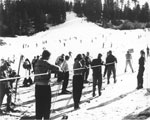
Moonridge Tow |

Big Bear Swing Lift |
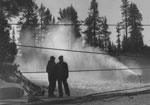
Rebel Ridge Early Snowmaking Efforts |
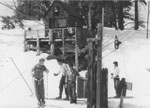
Ski Green Valley |
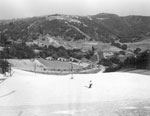
Ski Villa Carbon Canyon |

Swing Lift at Big Bear |

Snow Forest 1964 |
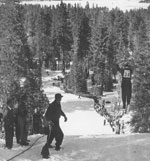
Snow Summit Jumping |

Snow Valley Single Chairlift 1950 |
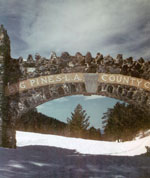
Arch at Big Pines |

Keller Peak 1939 |

Kratka Ridge |
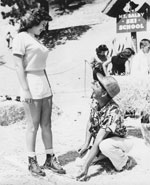
Mt. Baldy Ski School |
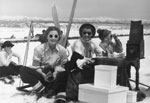
McGee Creek |

Mt. Waterman |

Hans Georg Ski School |
Email us at info@pacificrimalliance.org
Contents of this site Copyright © 1997-2019 by Pacific Rim Alliance. All rights reserved.
Site designed & maintained by Graphic Dezignz. Last updated October 17, 2017.
 |
 |
Skiing is a Dance in which the Mountain always Leads



